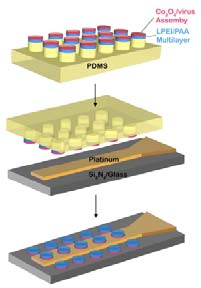
Current battery technology is limited by the fact that less than half of the battery assembly is occupied by active materials, a problem that typically becomes more pronounced as battery size is reduced. In order to enable the production of high performance microbatteries, researchers from the Massachusetts Institute of Technology have developed a new procedure to fabricate and position small battery components with nanostructured materials. Their technique involves the combination of several advanced technologies, including genetically engineered viruses, layer by layer assembly, biological self-assembly and templating, and microcontact printing.
The procedure, shown schematically in the figure, begins with the creation of a substrate with ordered cylindrical pins (either 4 or 8 microns in diameter). Once the substrate is formed, the following steps are followed to finish the anode assembly:
- On top of each pin, the polyelectrolyte layers that serve as the battery’s solid electrolyte and separator are deposited using layer by layer assembly.
- Genetically modified viruses then self-assemble to coat the top of the electrolyte layer.
- With their long length and nanoscale diameter, these viruses provide a template for the creation of cobalt oxide nanowires that function as the battery’s anode.
- A final microcontact printing step allows the transfer of the anode and polyelectrolyte to a series of 4 platinum microbands shaped for easy connection to external electrical contacts.
These researchers state the nanoscale cobalt oxide belongs to a new class of battery materials that has a higher storage capacity than carbon-based anodes currently used in lithium ion batteries. The genetic modification of the virus increases the affinity of the virus surface for cobalt ions, facilitating the creation of cobalt oxide nanowires from the virus template. The resulting structure performs as a fully functional electrochemical device.
Nanostructured microbatteries have potential use in a number of applications, including powering of micro- and nano-devices and use on flexible textiles and circuits. The researchers also indicate that their novel microbattery production method could potentially be adapted to create interdigitated electrodes and 3D architectures, offering even more versatility.
Supporting information:
http://www.pnas.org/content/early/2008/08/26/0711620105/suppl/DCSupplemental
Additional information available from MIT and Tim Prosser’s Blog.
Image from Nam, K.T., Wartena, R., Yoo, P.J., Liau, F.W., Lee, Y.J., Chiang, Y.M., Hammond, P.T., Belcher, A.M. “Stamped microbattery electrodes based on self-assembled M13 viruses” PNAS, published ahead of print August 27, 2008, (DOI 10.1073/pnas.0711620105). Reprinted with permission from PNAS.
